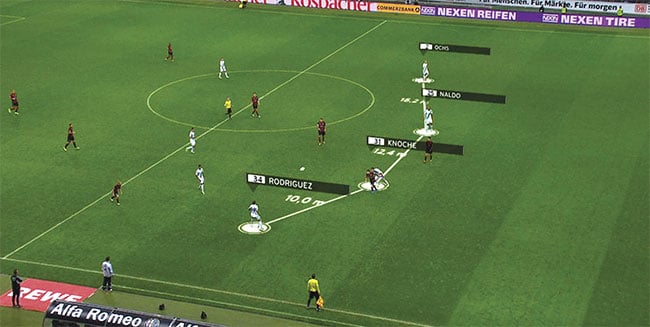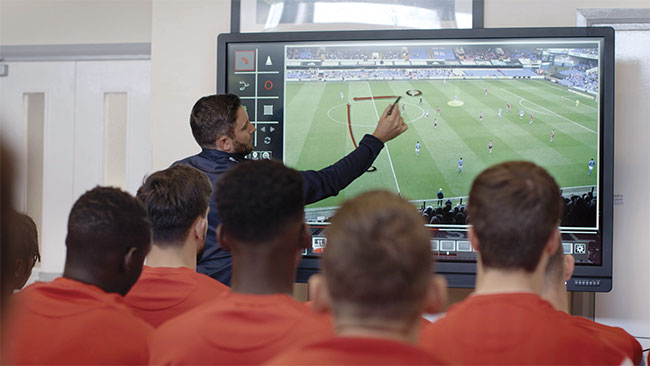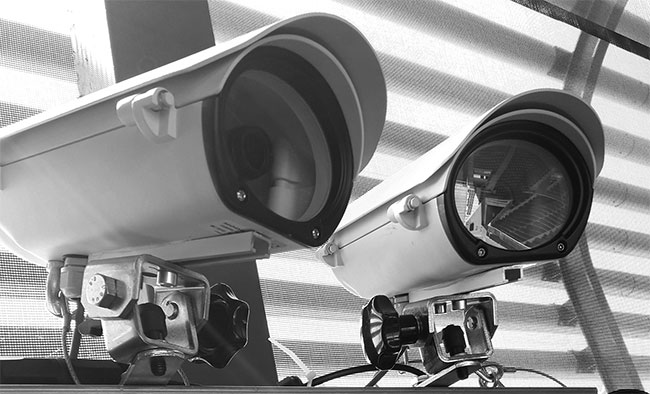HANK HOGAN CONTRIBUTING EDITOR
Sports are big business. Revenues of U.S.-based Major League Baseball hit $10.7 billion in 2019. The German Bundesliga, a top-tier soccer
league, took in over €4 billion ($4.5 billion) that same year. The 2018 World Cup final was seen by more than 516 million people around the world.

Moderators in a TV broadcast have markers and other tools for highlighting particular players when discussing tactical options or the special situations of a game and explaining them to the audience. Courtesy of ChyronHego.
Analyzing what’s going on during sporting events is also big. New York City-based ChyronHego provides tools for sports analysis through various data feeds, with tools and data streams based on vision technology. Eric Hayman, the company’s chief scientist, said some feeds are delivered live for automation and fan-engagement applications, while others arrive later — for applications in which the emphasis is on the quality of the data rather than the speed of its delivery. ChyronHego, however, focuses on maintaining high quality even for its live feeds.
Powering this analysis is an array of machine vision cameras. The cameras provide video for advanced algorithms that accurately track the positions of individual players and the ball. This data then yields information about distances, speeds, accelerations, and more.
“The great thing about that is we don’t have to change the equipment of the players or interfere in the game in any way,” Hayman said of the optical approach. “To be able to use a camera-based system is a huge advantage since it is completely nonintrusive.”
The ChyronHego optical sports tracking system, called TRACAB and used by the Bundesliga and other leading soccer leagues, can help coaching staff to assess player performance by determining how much ground a soccer player covers in a game, for instance. Armed with this knowledge, a coach may decide when a particular player is approaching a limit and should be pulled, possibly preventing an injury or a drop-off in performance. Broadcasters can use TRACAB to place stats or visualizations on TV screens or on websites to engage fans.

By using TRACAB optical tracking in combination with additional tools such as Coach Paint, coaches have the means to improve individual and team skills during training sessions. Courtesy of ChyronHego.

Teledyne DALSA’s Genie Nano cameras offer both the image quality and frame rates needed for ChyronHego’s TRACAB tracking system. Courtesy of ChyronHego.
This automated analysis requires enough resolution to distinguish one player from another, as well as enough to follow the ball. The vision system also has to provide 3D information. ChyronHego’s technology follows as many as 30 objects in a space as large as a soccer field — which is wider than a football field — to about an 8-cm or 3-in. accuracy.
While robust and accurate, the automated approach is not perfect. So part of ChyronHego’s service involves providing additional quality control checks, during which a person will look at the recorded images to ensure the system got everything right. Post-game corrections may be necessary, for example, if errors occur due to the action on the field.
“In some situations, such as soccer corner kicks, things can get messy. You can have a lot of people in the same small area for an extended period of time,” Hayman said.
As sporting event audience sizes
and revenues have grown, so too have ChyronHego’s needs for its vision systems, according to Hayman. The company’s latest-generation TRACAB provides several cameras in a unit,
with multiple units placed on each
side of the field. This layout presents challenges for cabling but it is necessary to help ensure reliable recording
of high-speed action.
In addition, outdoor sports take place in a variety of weather conditions, at different temperatures, and under various types of lighting. The need for cameras that were able to satisfy this combination of requirements challenged the company to find a solution.
After considering its options, ChyronHego selected Teledyne DALSA’s
Genie Nano cameras for the new, fifth-generation TRACAB. The cameras provide a 1936 × 1216 resolution at up to 30 fps with a global shutter, which together satisfy the company’s needs for high resolution and fast-action imaging. The cameras also have an integrated Ethernet interface that simplifies
cabling.
ChyronHego has its sights set on even higher-resolution cameras that could provide 4K or 3840- × 2160-pixel images. Combined with high-bandwidth connectivity, the higher resolution would make it feasible to
follow finer features, such as the location of a player’s limbs or the direction their head is facing. Knowing the latter may make it possible to get even closer to the action on the field by providing clues as to what a player might be thinking an instant before an action is taken.
Hayman said of head tracking, “It does give some indication of where a player is looking.”